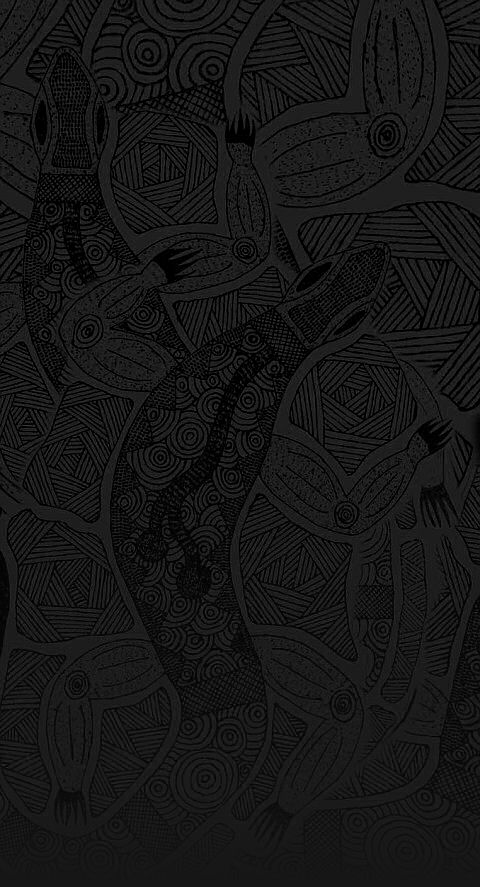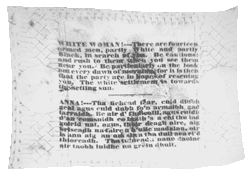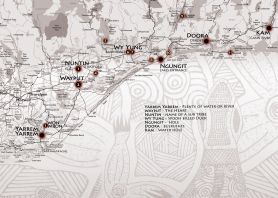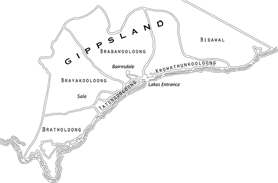
White Woman's Water Hole
Won Wron State Forest Bratwoloong Country
Captive or a devious fiction?
 Perhaps the biggest story to come out of Gippsland in the 1840s was the search for a lost white women said to have been held captive by some Gunaikurnai people.
Perhaps the biggest story to come out of Gippsland in the 1840s was the search for a lost white women said to have been held captive by some Gunaikurnai people.
Local legend has it that in the 1840s, a young woman, the sole survivor of a shipwreck off the nearby Ninety Mile Beach was taken and held captive by the local tribe of Bratwoloong, who inhabited this part of Gippsland.
Angus McMillan, an explorer who later squatted on land in Gippsland for his own pastoral requirements, started this story in the 1840s, with a letter to the Sydney Press. McMillan claimed he had come across a deserted Gunaikurnai camp strewn with an array of items, including female clothing and a dead baby, said by a Dr. Alexander Arbuckle to be a white child.
The story of the captive white woman developed a life of its own, spawning numerous myths, with various versions even claiming a sighting of a white woman being hurried away.  This lead to search parties consisting of Angus McMillan’s men and Native Police pursuing Gunaikurnai people to try to rescue her. The woman, if she ever existed, was never found. A ship’s figurehead however, was recovered, leading to speculation that it may have been mistaken for the white women.
This lead to search parties consisting of Angus McMillan’s men and Native Police pursuing Gunaikurnai people to try to rescue her. The woman, if she ever existed, was never found. A ship’s figurehead however, was recovered, leading to speculation that it may have been mistaken for the white women.
This White Woman of Gippsland story is believed to have been used to justify the killings of many Aboriginal people, particularly the Gunaikurnai. Massacres of the Gunaikurnai led by McMillan occurred at Nuntin, Boney Point, Butchers Creek, Maffra and at other unspecified locations throughout Gippsland. A massacre at nearby Warrigal Creek is recognised as one of the worst in Australian settlement history.
The White Woman’s Waterhole commemorates the tragedy of this story.
Bratwoloong is one of the five clans of the Gunaikurnai. The Bratwoloong people occupied the area from Wilson's Promontory to Loch Sport on the Gippsland Lakes.
Maps


Contact
Krowathunkooloong Keeping PlaceGippsland and East Gippsland Aboriginal Co-operative 37 - 53 Dalmahoy Street
Bairnsdale
Tel: (03) 5152 1891
Visitor Information Centres Orbost (03) 5154 2424
Lakes Entrance (03) 5155 1966
Bairnsdale (03) 5152 3444
Maffra (03) 5141 1811
Sale 1800 677 520
Sites
- white woman's waterhole
won wron state reserve - the lagoon
sale common state game reserve - the knob reserve
stratford - ramahyuck cemetery
perry bridge - den of nargun
mitchell river national park - krowathunkooloong keeping place
bairnsdale - howitt park
bairnsdale - legend rock
metung - buchan caves
buchan - burnt bridge reserve
lake tyers forest park - salmon rock and gunai boardwalk
cape conran

Please treat all sites along the trail with respect and care to ensure they are preserved for future generations.
Development of the Bataluk Cultural trail is a joint initiative of the Far East Gippsland Aboriginal Corporation, Gippsland and East Gippsland Aboriginal Co-operative, Lake Tyers Aboriginal Trust, Moogji Aboriginal Council, Ramahyuck Aboriginal Corporation, East Gippsland Shire Council and Wellington Shire Council.